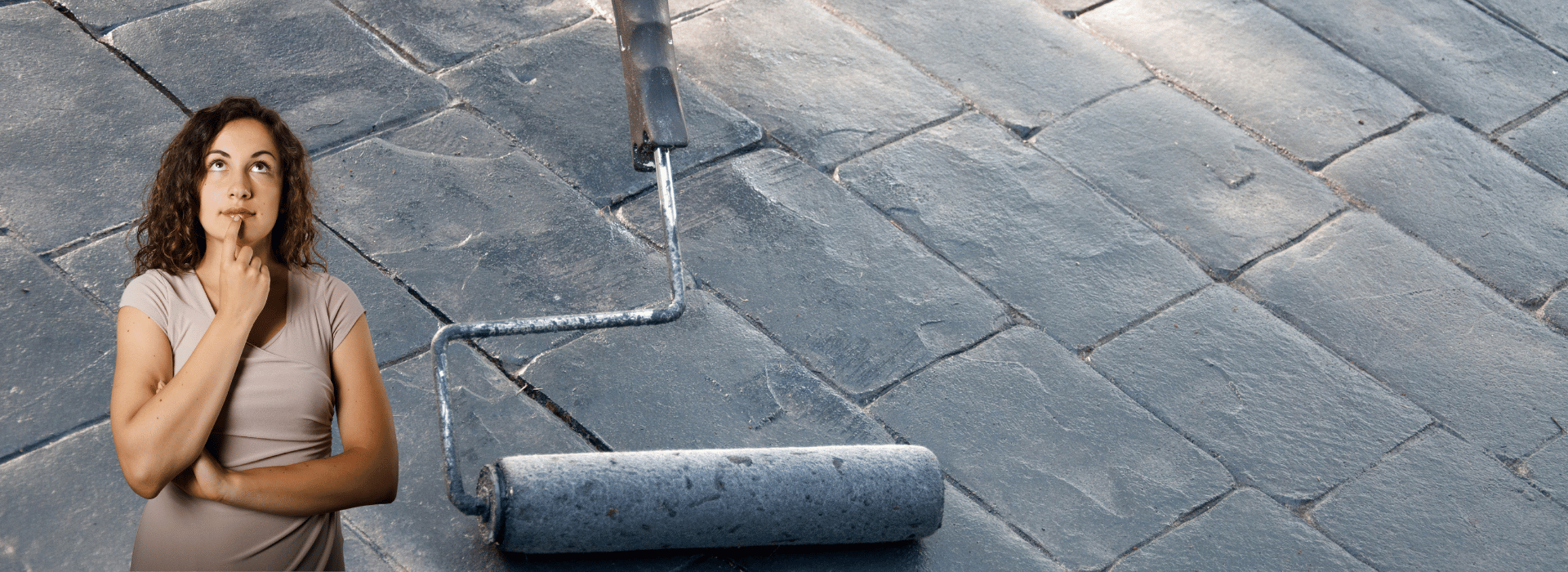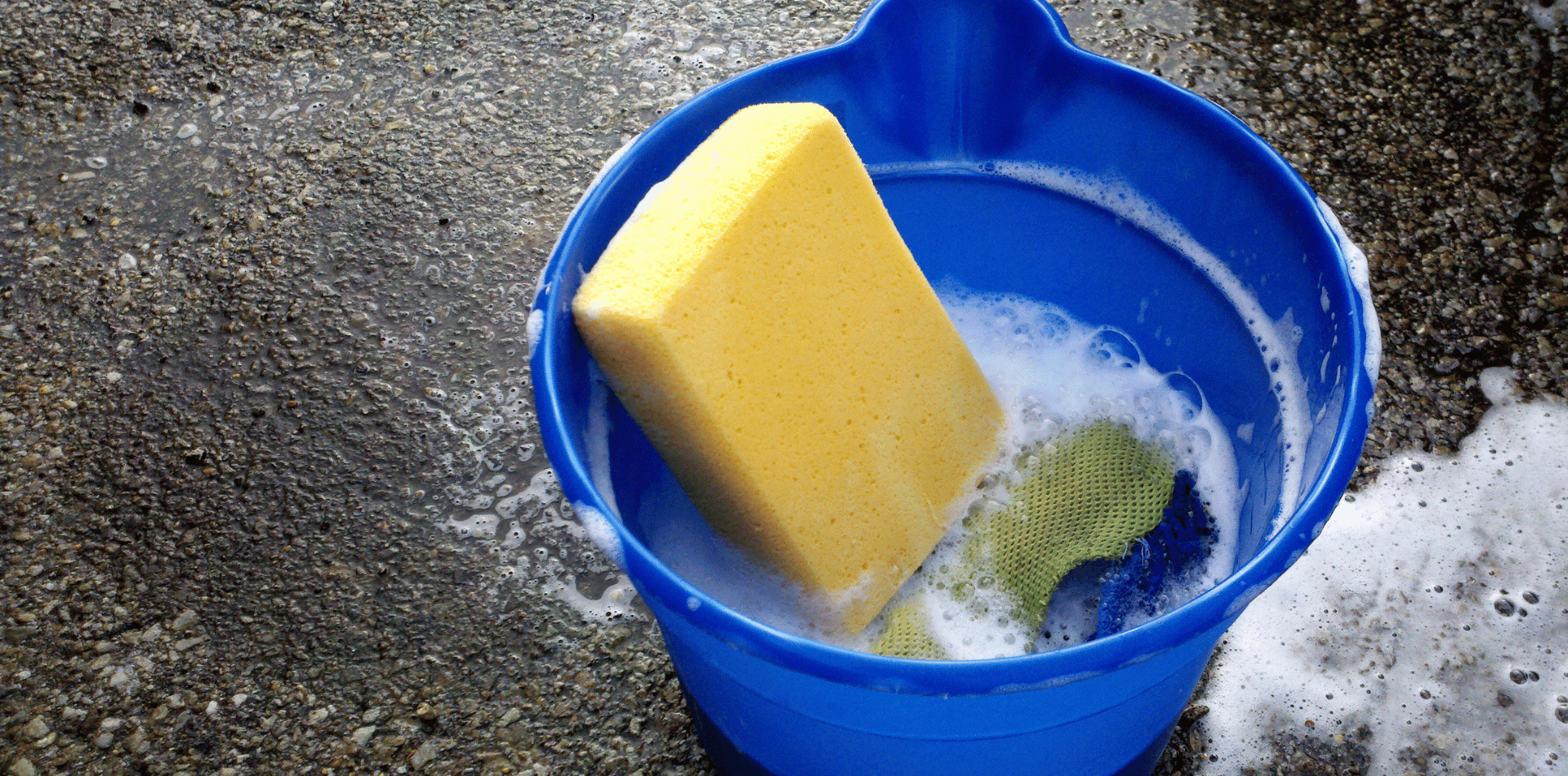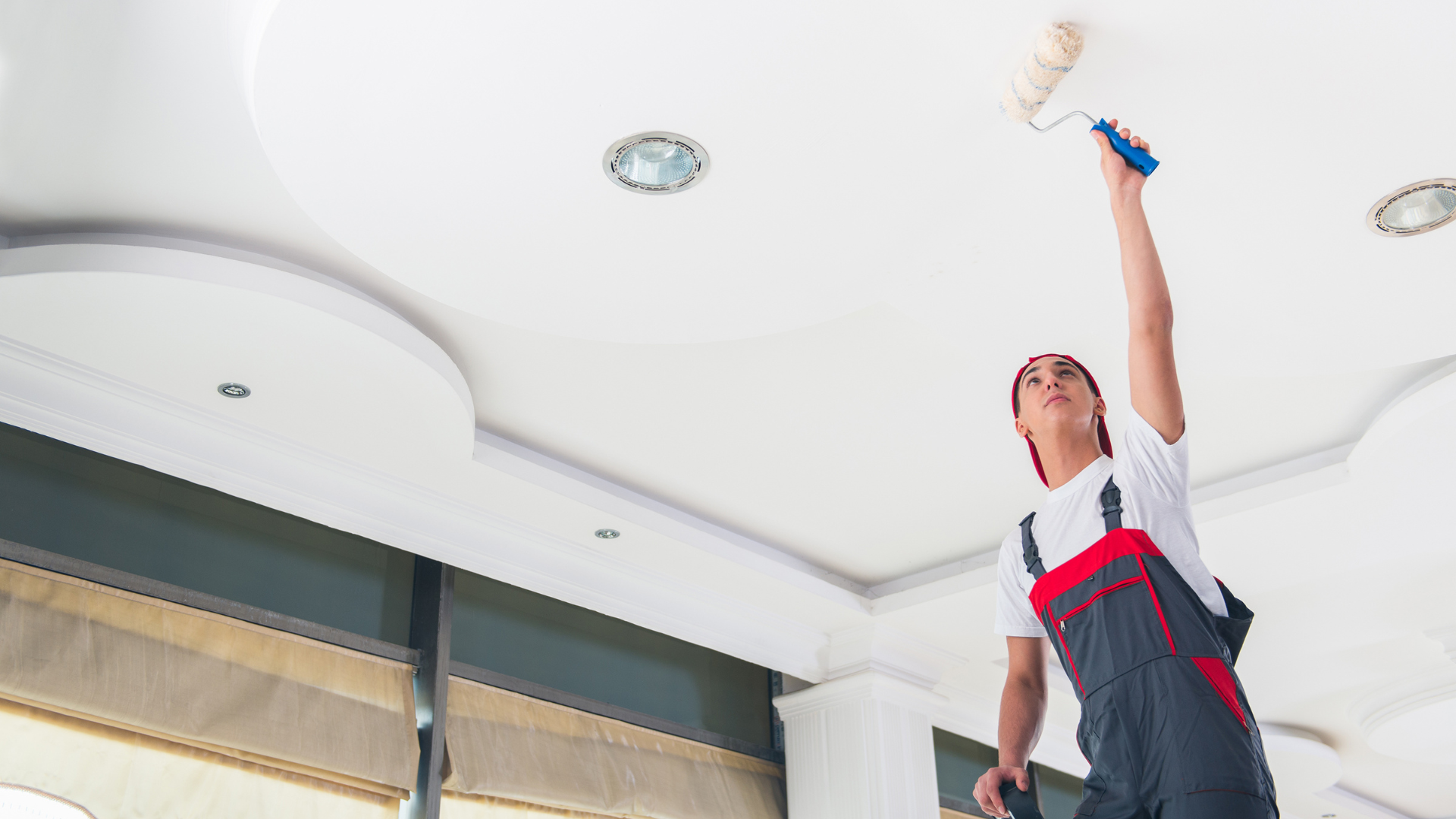The Importance of Correctly Maintaining Your Painted Concrete Driveway.

Your driveway is often one of the first things people see when they visit your home, and a well-maintained driveway can not only boost your home’s curb appeal but also its value.
Painted concrete driveways, in particular, require specific maintenance to keep them looking their best and to extend their lifespan.
We'll explore the reasons maintaining your painted concrete driveway is essential, and how you can effectively do so.
Why Maintenance Matters
Protecting Your Investment
When you decide to paint your concrete driveway, you are not only choosing to enhance its appearance but also to add a layer of protection that extends its lifespan and functionality.
Here's how proper maintenance serves as a crucial investment in preserving your painted concrete driveway:
Shielding from the Elements
Concrete is a porous material, which means it absorbs water.
In regions with freeze-thaw cycles, this can lead to significant damage over time. Water that seeps into concrete can freeze, expand, and then thaw, causing the material to crack and break apart. A high-quality paint specifically designed for concrete creates a barrier that minimizes water absorption and protects against such damage. Additionally, the paint shields the driveway from harmful UV rays that can cause the concrete to deteriorate over time. Regular maintenance ensures this protective layer remains effective, reducing the impact of the elements.
Resistance to Stains and Chemicals
Driveways are often subjected to various chemicals, from automotive oils and fluids to road salts and de-icers. These substances can penetrate unprotected concrete, leading to stains, chemical reactions, or even structural damage over time. The paint on a concrete driveway acts as a sealant, making it easier to clean and less permeable to these harmful substances. Regular cleaning as part of maintenance helps prevent stains from setting in, preserving the driveway’s aesthetic appeal and structural integrity.
Preventing Surface Wear and Tear
The constant weight of vehicles and foot traffic can wear down the surface of a concrete driveway. An unpainted concrete driveway might start showing patches where the finish is worn off, making it susceptible to further damage. Paint adds a layer of durability, helping to distribute and resist these pressures more evenly. However, this painted surface can degrade over time due to mechanical wear, weather conditions, and chemical exposure. Through regular maintenance, such as reapplying paint and sealant, you can protect against the gradual wear and tear, keeping the surface smooth and intact.
Maintaining Structural Integrity
Underneath the cosmetic improvements, the structural integrity of the concrete is paramount. Cracks and potholes not only look unattractive but can also become hazardous, potentially causing damage to vehicles or becoming tripping hazards. Regular inspections and maintenance can catch these problems early when they are easier and less expensive to fix. This proactive approach prevents minor issues from escalating into major repairs that could require a complete overhaul of the driveway.
Economic Benefits
Investing in regular maintenance might seem like an added expense, but it is far more economical than facing the hefty costs associated with major repairs or full replacements. Maintaining the paint and sealant on your driveway extends its lifespan, which means you can defer the significant expense of replacing large sections of concrete. Moreover, a well-maintained driveway can enhance the overall value of your property, proving beneficial if you decide to sell your home.
In conclusion, the importance of maintaining your painted concrete driveway cannot be overstated. It is essential for protecting your investment from environmental elements, chemical stains, surface wear, and structural damage. Regular upkeep not only saves money in the long run but also keeps your driveway looking great and functioning well for years to come.
Enhancing Street Appeal Through Driveway Maintenance
A driveway is more than just a practical space for parking vehicles; it's a significant component of your home's street appeal. The condition and appearance of your painted concrete driveway can profoundly influence the first impression it makes.
Here’s a closer look at how maintaining your driveway enhances its street appeal and the broader impact this has:
Vibrant Colours and Finish
A freshly painted driveway with a vibrant colour and smooth finish can dramatically transform the appearance of your home's exterior. Over time, however, exposure to sunlight, harsh weather, and vehicle fluids can dull the paint and cause it to chip or peel. Regular cleaning, timely repairs, and recoating with paint and sealant not only restore its original beauty but can also allow for an update in colour or finish to align with current trends or personal preferences. This ongoing attention helps maintain the aesthetic integrity of the driveway, ensuring it continues to enhance the property's overall look.
Boosting Home Value
The curb appeal of your home plays a critical role in its marketability and perceived value. A well-maintained driveway signals to potential buyers that the property is cared for, which can translate into higher interest and potentially a higher selling price. In real estate, first impressions can be pivotal; many buyers make subconscious decisions about a home within the first few moments of viewing. A driveway that looks new and well cared for contributes positively to that crucial first impression.
Creating a Welcoming Atmosphere
The entrance to your home, including the driveway, sets the tone for the entire property. A driveway that is clean, vibrant, and free of cracks and weeds is more welcoming to guests and offers a sense of pride and satisfaction every time you return home. This can be particularly important in neighbourhoods where aesthetic standards are high, helping your property to stand out positively.
Enhancing Landscaping and Architectural Features
A maintained driveway complements the landscaping and architecture of your home. For instance, a driveway's colour can be chosen to harmonise with the home's exterior paint or to contrast attractively with the surrounding garden. Additionally, the clean lines of a well-maintained driveway can enhance the geometric or designed elements of your property's architecture and landscaping, creating a cohesive and attractive overall appearance.
Setting the Property Apart
In competitive housing markets, every detail counts. Properties with a high level of street appeal, including a pristine driveway, often sell faster than those without. This is because a well-maintained exterior suggests a well-maintained interior, making the property more appealing to discerning buyers. Maintaining your driveway is a relatively simple way to set your property apart from others in the neighbourhood, particularly when many potential buyers judge a book by its cover.
The maintenance of your painted concrete driveway is crucial not just for the practical benefits it provides in terms of longevity and protection, but also for the aesthetic value it adds to your home. Keeping your driveway in top condition enhances its curb appeal, boosts your property's value, and makes a lasting impression on everyone who visits or passes by your home.
Preventing Costly Repairs Through Routine Maintenance
Routine maintenance of a painted concrete driveway is not just about aesthetics; it plays a crucial role in preempting extensive and expensive repairs. Small issues, if left unaddressed, can quickly escalate, leading to severe damage that is costly to fix.
How can regular maintenance prevent these problems and save homeowners money in the long run?
Early Detection of Minor Issues
The key to avoiding costly repairs is catching potential problems early. This can include identifying small cracks, chips in the paint, or the beginning signs of wear. These minor issues are often inexpensive and straightforward to fix if they are addressed promptly. Regular inspections and maintenance checks can help you spot these problems before they worsen. For example, resealing a small crack in a driveway is a relatively easy and affordable task, but if water seeps into that crack and freezes, the expansion can cause significant damage, requiring more extensive repair work.
Extending Driveway Lifespan
Routine maintenance not only fixes existing small problems but can also prevent future issues. By keeping the driveway’s paint and sealant in good condition, you protect the underlying concrete from elements that could deteriorate it over time. This includes protection from water penetration, UV damage, and chemical corrosion. Extending the lifespan of your driveway means you can defer the substantial expense and inconvenience of having to replace it entirely—a process that is both disruptive and costly.
Maintaining Structural Integrity
The structural integrity of a driveway is paramount for safety and durability. Small cracks and chips can evolve into potholes or larger cracks, which in turn compromise the driveway's structure. These larger issues are much more expensive to repair and can lead to further problems, such as damage to vehicles or drainage issues on your property. Regular maintenance ensures that the surface and structure of the driveway are preserved, thereby avoiding the cascade of damages that can follow when minor damages are ignored.
Reducing Long-Term Expenses
Investing in regular maintenance can significantly reduce the total cost of ownership of a driveway. The expense of periodic sealing, minor crack filling, or occasional repainting is minimal when compared to the costs associated with major repairs like resurfacing or replacing sections of the driveway. Additionally, well-maintained driveways require less frequent major repairs, spreading those costs over a more extended period and making budgeting for home upkeep more predictable and manageable.
Enhancing Safety and Functionality
Neglected driveways can become safety hazards, with uneven surfaces leading to tripping or vehicle damage. Keeping your driveway in good repair ensures it remains functional and safe for use. This is particularly important in residential areas where children or elderly individuals might be at greater risk from uneven or damaged surfaces.
Optimising Resale Value
When the time comes to sell your home or commercial, a driveway in poor condition can be a significant detractor for potential buyers, potentially lowering offers or leading to requests for repair credits during the sale process. Regular maintenance keeps your driveway looking attractive and in good structural condition, thus enhancing the overall appeal and value of your property in the competitive real estate market.
Regular maintenance of your painted concrete driveway is a wise investment. It allows for the early detection and repair of minor issues, helps maintain the structural integrity and functionality of the driveway, extends its lifespan, and ultimately saves money by avoiding more severe and costly repairs. This proactive approach not only preserves the aesthetic and functional aspects of the driveway but also contributes to the overall safety and value of your property.

How to Maintain Your Painted Concrete Driveway
Regular Cleaning: The Foundation of Driveway Maintenance
Maintaining the cleanliness of your painted concrete driveway is fundamental to preserving both its appearance and longevity. Regular cleaning not only keeps your driveway looking great but also prevents long-term damage caused by the build-up of harmful substances.
Here’s how to effectively clean and care for your painted concrete driveway:
Routine Surface Cleaning
The first step in driveway maintenance is regular surface cleaning.
This involves removing loose debris such as leaves, twigs, dirt, and garbage. Such debris can trap moisture against the driveway surface, potentially leading to mold or mildew growth and surface degradation over time. Using tools like a broom, leaf blower, or a garden hose can effectively clear your driveway of these everyday accumulations. It’s beneficial to incorporate this type of cleaning into your weekly routine to keep your driveway in top condition.
Dealing with Stains Promptly
Driveways can easily become stained, especially from cars leaking oil or other fluids.
To tackle tough stains like oil or grease, it’s important to act quickly before the stain can penetrate deeply into the paint and concrete. For effective cleaning, use a mild detergent mixed with water and apply it to the stain. Scrub the area with a stiff nylon brush, which provides the necessary abrasion to remove the stain without damaging the paint. After scrubbing, rinse the area thoroughly with water. For particularly stubborn stains, you may need to apply a degreaser or a specialized concrete cleaning product designed for use on painted surfaces.
Periodic Deep Cleaning
In addition to weekly surface cleaning, consider giving your driveway a thorough wash periodically. This can be done using a pressure washer set to a low pressure to avoid damaging the paint. Pressure washing can remove built-up grime and residues that regular cleaning might miss. It’s especially useful for restoring the driveway’s appearance and preparing it for other maintenance tasks like sealing or touch-up painting. However, it’s essential to use the pressure washer correctly—too high a pressure or holding the nozzle too close to the surface can strip off the paint.
Avoiding Harmful Chemicals
When cleaning your painted concrete driveway, it’s crucial to avoid harsh chemicals that can strip the paint or degrade the concrete. Bleach, for example, can be too harsh for painted surfaces. Stick to cleaners that are specifically labeled as safe for use on painted concrete. Always test any new cleaning solution on a small, inconspicuous area of the driveway to ensure it does not damage the paint.
Seasonal Considerations
The changing seasons bring different challenges for maintaining a driveway. In fall, it’s important to keep the driveway clear of leaves, which can become wet and slippery, posing a hazard and potentially staining the driveway. In winter, avoid using corrosive de-icing salts on your painted concrete, as these can degrade both the concrete and the paint. Opt instead for less corrosive alternatives like calcium magnesium acetate or sand for traction.
Regular cleaning is a simple yet effective way to maintain the aesthetic appeal and structural integrity of your painted concrete driveway. By incorporating these cleaning practices into your maintenance routine, you can prevent damage, extend the life of the driveway, and ensure that it continues to enhance the street appeal of your home.
Sealant Application: Enhancing Protection and Longevity
Applying a sealant to your painted concrete driveway is a critical maintenance step that serves multiple protective functions. It significantly extends the life of both the paint and the concrete beneath by guarding against environmental and chemical damages.
Here’s a detailed guide on why sealant application is essential and how to effectively apply it:
Why Apply Sealant?
Sealants are designed to create a barrier on the surface of the driveway that protects against various forms of damage:
- UV Protection: Just like the sun’s UV rays can cause skin damage, they can also degrade and fade paint over time. A sealant helps to block these rays, preserving the colour and integrity of the driveway paint.
- Moisture Resistance: Sealants prevent water from penetrating the concrete, which is crucial to avoid the freeze-thaw damage that can create cracks and other structural issues.
- Chemical Resistance: Driveways are often exposed to chemicals like oil, gasoline, and de-icing salts. A good sealant prevents these substances from soaking into the concrete and causing stains or deterioration.
Choosing the Right Sealant
There are several types of sealants available, including acrylic, epoxy, and polyurethane.
Each has different properties and benefits:
- Acrylic sealants are easy to apply and relatively inexpensive but may need more frequent reapplication.
- Epoxy and polyurethane sealants offer more durability and stronger protection against chemicals and oil but can be more expensive and require more careful application.
Select a sealant that is appropriate for painted concrete surfaces, and ensure it provides the level of protection you need based on your local climate and the level of vehicular and pedestrian traffic your driveway experiences.
Preparing for Application
Before applying sealant, thoroughly clean the driveway as described earlier. Ensure that any repairs, such as filling cracks or touching up paint, are completed. The driveway must be completely dry before applying sealant; otherwise, you might trap moisture beneath the sealant layer, which could lead to damage over time.
Applying the Sealant
Sealant can be applied using a roller or a sprayer, depending on the product specifications and your preference. Begin by applying a thin, even coat of sealant, working from one edge of the driveway to the other. Be careful to avoid creating puddles of sealant, which can lead to uneven coverage and reduce the effectiveness of the sealant.
After applying the first coat, allow it to dry according to the manufacturer's instructions—typically this takes at least 24 hours. Depending on the product and the level of protection you desire, a second coat might be necessary. If so, apply it perpendicular to the first coat to ensure even coverage.
Frequency of Reapplication
The longevity of a sealant depends on various factors, including the type of sealant, the climate, and the amount of traffic the driveway receives. Generally, it’s recommended to reapply sealant every 2-3 years, but in areas with harsh weather conditions or high traffic, more frequent applications might be necessary.
Maintenance After Sealing
Once sealed, the driveway will be easier to clean and maintain. Spills and stains can be wiped away more easily, and the surface is less likely to suffer from the abrasive effects of dirt and grit. Regular cleaning and periodic inspections for damage will help maintain the effectiveness of the sealant and extend the life of your driveway.
By applying sealant to your painted concrete driveway, you ensure enhanced protection against environmental elements and wear, which helps maintain its appearance and functionality for years. This preventative measure is an investment in the longevity and aesthetics of your property.
Repairing Damages Promptly: Key to Driveway Longevity
Timely repair of damages in a painted concrete driveway is crucial for preventing minor issues from escalating into major, costly repairs. Regular inspection and immediate action to address damages not only maintain the driveway's structural integrity but also its aesthetic appeal.
Here’s why prompt repair is necessary and how to effectively manage common types of damage:
Why Immediate Repairs are Important
- Water Damage Prevention: Cracks and chips in the paint expose the underlying concrete to water intrusion. Water that seeps into concrete can freeze, expand, and cause further cracking, leading to a cycle of deterioration that compromises the driveway's integrity.
- Structural Safety: Unrepaired damages can lead to larger structural problems, such as potholes and major cracks. These not only affect the driveway’s appearance and performance but also pose safety risks to vehicles and pedestrians.
- Cost Efficiency: Addressing damages when they are still minor is generally less expensive than waiting until they become severe. Early repairs can prevent the need for more extensive, disruptive, and costly interventions like full resurfacing or replacement.
Regular Inspections
- Schedule regular inspections of your driveway to identify any signs of wear or damage. This can be done seasonally, especially after harsh weather conditions, which are likely to exacerbate existing small damages or create new ones.
Handling Minor Cracks and Chips
- Surface Cracks: Small cracks can be easily filled using a concrete crack filler or sealant. These products are designed to expand and contract with the weather, which helps keep the crack sealed against moisture.
- Chips and Flaking: For areas where the paint has chipped or flaked off, use a stiff brush to remove loose paint, clean the area thoroughly, and apply a matching paint to cover the exposed concrete. This not only restores the look of the driveway but also reseals the surface against water and chemical penetration.
Using Concrete Patching Compounds
- For slightly larger cracks or small holes, a concrete patching compound is ideal. These compounds are specially formulated to adhere to existing concrete and fill in gaps or depressions. Follow the manufacturer's instructions for mixing and applying the patching compound. Ensure the area is clean and moist before application to aid adhesion. After filling, allow it to cure as directed before applying paint or sealant over the patched area.
Repainting and Resealing
- Once repairs are made, it’s important to repaint and reseal the repaired area to restore the protective layer fully. This might involve touching up small areas with paint matched to the existing colour and finish, followed by a sealant application over the entire surface to ensure uniform protection.
Dealing with Larger Damages
- For more significant damages such as large cracks or potholes, it may be necessary to remove the damaged section of concrete and fill it with new concrete or an appropriate filler material. These repairs are more complex and might require professional assistance to ensure that the new material bonds correctly with the old and that the repair is seamless and effective.
Maintaining Consistency
- Ensure that the materials used for repairs are compatible with your existing driveway materials. This consistency will not only ensure that the repairs last but also help maintain a uniform appearance across the driveway.
By adopting a proactive approach to maintaining and repairing your painted concrete driveway, you can extend its lifespan, enhance its appearance, and ensure it continues to add value and functionality to your property. Timely repairs protect your investment by preventing minor damages from becoming extensive problems that require costly and extensive remedies.
Avoiding Harmful Chemicals: Safeguarding Your Painted Concrete Driveway
The chemicals you use on your painted concrete driveway can significantly affect its durability and appearance.
Whether it's during routine cleaning or winter maintenance, choosing the right products is crucial to prevent damage. Here’s why avoiding harsh chemicals is important and what alternatives you can use to maintain your driveway safely:
The Risk of Harsh Chemicals
- Damage to Protective Coatings: Harsh chemicals, including certain cleaners, can strip away the protective paint and sealant layers on concrete driveways. This exposure accelerates wear and increases vulnerability to weather elements.
- Concrete Deterioration: Strong acidic or alkaline cleaners can react with the concrete itself, leading to surface deterioration and structural weaknesses over time.
- Environmental Concerns: Runoff from chemical cleaners can harm local flora and fauna. Choosing environmentally friendly products helps minimise this impact.
Choosing the Right Cleaning Products
- Mild Detergents: Opt for pH-neutral or mild soaps for cleaning your driveway. These cleaners are gentle enough not to damage the paint or the concrete while still being effective at removing dirt and grime.
- DIY Solutions: A mixture of vinegar and water can be used for light cleaning tasks and is harmless to both concrete and its finish. For oil stains, baking soda or a paste of laundry detergent and water can be applied to the area, left to sit, and then scrubbed off, offering a gentle yet effective cleaning solution.
- Proper Application and Rinsing: Whatever cleaning product you choose, always ensure that it is thoroughly rinsed off the driveway to prevent any residue from damaging the surface over time.
Routine Maintenance and Care
- Regular Washing: Frequent rinsing of your driveway with just water can prevent the build-up of potentially harmful substances. A regular hose down can keep the surface clean and reduce the need for stronger cleaning agents.
- Immediate Clean-up: Promptly cleaning up spills, especially from substances like oil and gasoline, can reduce the need for aggressive chemicals to remove them later.
Educating Yourself on Products
- Check Labels: Always read and follow the instructions on cleaning products. Look for warnings related to use on painted or concrete surfaces.
- Seek Recommendations: If unsure, seek recommendations from professionals or local home improvement stores on the best products for maintaining painted concrete driveways.
By avoiding harmful chemicals and opting for safer alternatives, you not only protect your painted concrete driveway from premature wear and damage but also contribute to a healthier environment. This cautious approach helps maintain the aesthetic appeal and structural integrity of your driveway over the long term.
Maintaining a painted concrete driveway is not just about keeping it looking good; it's also about preserving and enhancing the lifespan of the investment.
By adopting a regular cleaning schedule, repairing damages promptly, and using the right products for maintenance, you can ensure your driveway remains in top condition for years to come.
Remember, the key to prolonging the life of your driveway lies in regular, preventative maintenance rather than waiting for visible signs of wear and damage.





